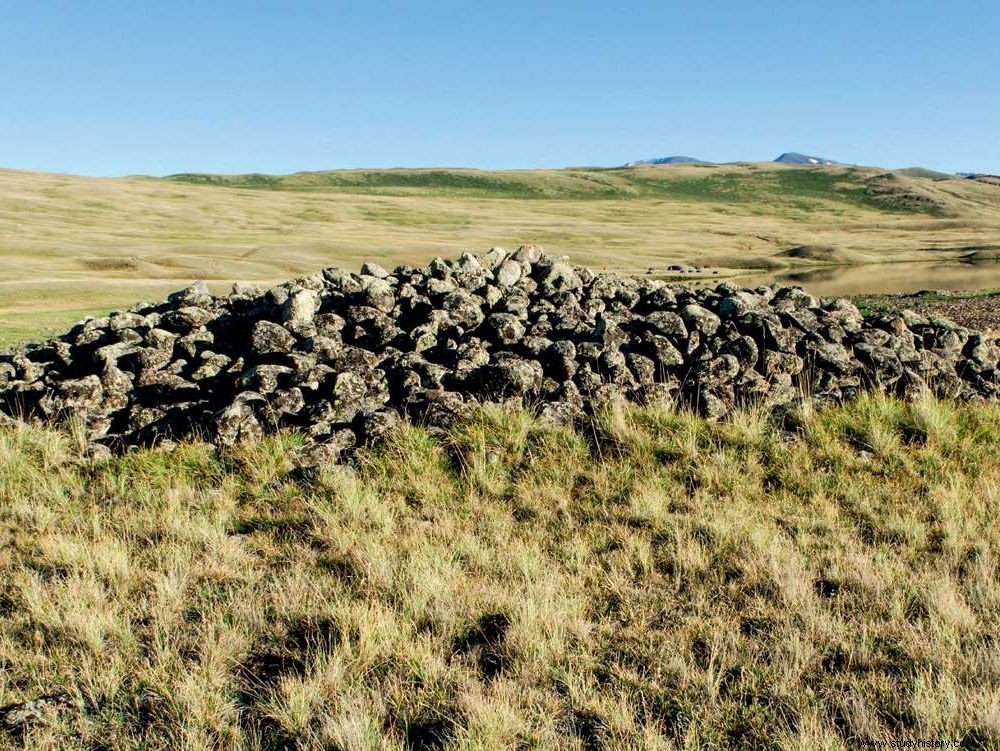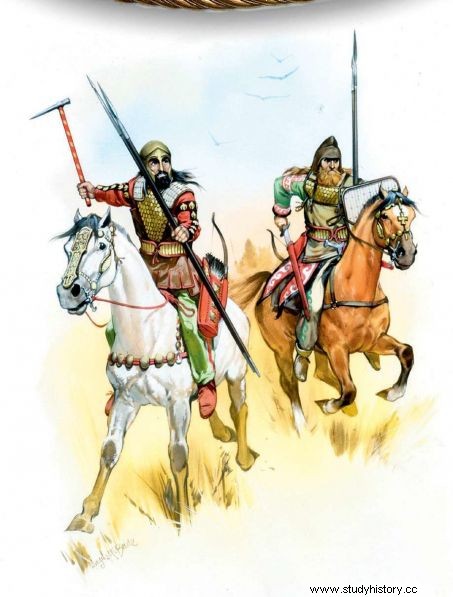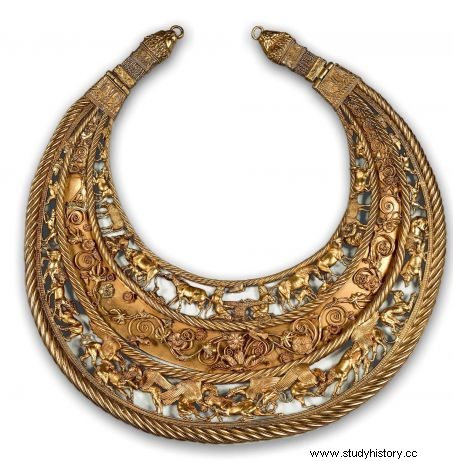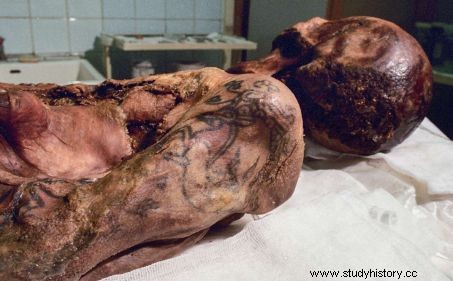The study of ancient genomes has made it possible to trace the rise and fall of the Scythians, one of the most fascinating nomadic cultures of the Central Asian steppes during the Iron Age.

Many burial mounds or Kurgans built by the Scythians have been found in the Altai region of Russia (here in the Sailiuguem mountains).
This article is from the magazine Sciences et Avenir- La Recherche n°893/ 894 dated July-August 2021.
"Any Scythian who kills for the first time drinks the blood of its victim; to the enemies whom he strikes down in a battle, he cuts off the head which he presents to the king; if he presents a head, he has his share of the conquered booty. Sometimes the Scythians tan the skin of their enemies, others saw off their skulls to turn them into drinking cups." The author of these unkind descriptions? The Greek historian Herodotus, in Book IV of his famous Inquiry (5th century BC). In what is the oldest complete prose text that has come down to us from antiquity, the author portrays the Scythians whom he encountered near the Black Sea, during his stay in the Greek colony of Olbia in the Bridge (in present-day Ukraine). It is also on the territory of the Scythians that Aeschylus places his tragedy Chained Prometheus , in which the Titan is condemned to have his liver devoured every day… This shows how much the cruel character attached to these peoples obsessed the Ancients. For the Greek authors, they are nothing but appalling "barbarians". However in Antiquity, the term "Scythian" mainly concerns the populations established north of the Black Sea (called Pont-Euxin by the Greeks), in the Pontic steppe. Those whom the Greek colonists came into close contact with are those that historians sometimes call "European Scythians", to distinguish them from the "Scythians of the steppes".
The Scythians actually encompassed several Iron Age (8th-2nd century BC) cultures that dominated Central Asia. "This unique name is a conventional name that historians and archaeologists have borrowed from the Greeks. In fact, these populations were called differently depending on the region. Sakkas" , says Henri-Paul Frankfurt, emeritus research director at the CNRS, head of the French Archaeological Mission in Central Asia. And the territory of these riders, nomadic shepherds and fearsome archers stretched over thousands of kilometers, from the shores of the Black Sea to those of the Yellow River, in China! They thus multiplied the contacts with the great contemporary civilizations of Eurasia (Greeks, Persians, etc.). Their legendary size is due, among other things, to the immense funerary mounds (kourgans) that they erected and from which prodigious treasures have been unearthed. But also to the mythical Amazons, undoubtedly inspired by the European Scythians.
This article is from the magazine Sciences et Avenir- La Recherche n°893/ 894 dated July-August 2021.
"Any Scythian who kills for the first time drinks the blood of its victim; to the enemies whom he strikes down in a battle, he cuts off the head which he presents to the king; if he presents a head, he has his share of the conquered booty. Sometimes the Scythians tan the skin of their enemies, others saw off their skulls to turn them into drinking cups." The author of these unkind descriptions? The Greek historian Herodotus, in Book IV of his famous Inquiry (5th century BC). In what is the oldest complete prose text that has come down to us from antiquity, the author portrays the Scythians whom he encountered near the Black Sea, during his stay in the Greek colony of Olbia in the Bridge (in present-day Ukraine). It is also on the territory of the Scythians that Aeschylus places his tragedy Chained Prometheus , in which the Titan is condemned to have his liver devoured every day… This shows how much the cruel character attached to these peoples obsessed the Ancients. For the Greek authors, they are nothing but appalling "barbarians". However in Antiquity, the term "Scythian" mainly concerns the populations established north of the Black Sea (called Pont-Euxin by the Greeks), in the Pontic steppe. Those whom the Greek colonists came into close contact with are those that historians sometimes call "European Scythians", to distinguish them from the "Scythians of the steppes".
The Scythians actually covered several Iron Age (8th - 2nd century BC) cultures that dominated Central Asia. "This unique name is a conventional name that historians and archaeologists have borrowed from the Greeks. In fact, these populations were called differently depending on the region. Sakkas" , says Henri-Paul Frankfurt, emeritus research director at the CNRS, head of the French Archaeological Mission in Central Asia. And the territory of these riders, nomadic shepherds and fearsome archers stretched over thousands of kilometers, from the shores of the Black Sea to those of the Yellow River, in China! They thus multiplied the contacts with the great contemporary civilizations of Eurasia (Greeks, Persians, etc.). Their legendary size is due, among other things, to the immense funerary mounds (kourgans) that they erected and from which prodigious treasures have been unearthed. But also to the mythical Amazons, undoubtedly inspired by the European Scythians.

The Scythians were formidable warriors. They usually fought on horseback, equipped with bows and spears. Credit:AKG IMAGES
A story that has remained little known for a long time
However, the history of the Scythians, which runs for almost half a millennium from the transition between the Bronze Age and the Iron Age where they appear around 800 BC, until their decline around 250 BC, remained poorly known for a long time. And this despite the information transmitted by Greek, Roman, Persian or Chinese epigraphic sources. Despite also the formidable archaeological discoveries, some of which were made during the reign of Tsar Peter the Great (1672-1725). Similarly, the links between the various Scythian cultures evolving in the vast plains of Central Asia have long remained rather vague. "But since 2015, the genetics came to shake everything up" , declares the paleogeneticist Ludovic Orlando, director of research at the CNRS, director of the Center for Anthropobiology and Genomics of Toulouse (CNRS and Paul Sabatier University), a specialist in these regions that he travels regularly. He himself is the co-author of genomic analyzes of steppe peoples published in the journal Nature in 2015 and 2018.
So many pioneering works that come to clarify a brand new study. Produced by an international team of geneticists, anthropologists and archaeologists led by scientists from the Department of Archaeogenetics of the Max-Planck Institute for the History of Humanity in Jena (Germany), it sheds light on a complex story. Conducted under the direction of Guido Alberto Gnecchi Ruscone, it is based on the examination at the genomic scale of 111 individuals from 39 sites of the main Scythian and non-Scythian archaeological cultures present in Central Asia (Kazakhstan) in the 1st millennium BC. time. "The results obtained attest that important genetic changes have taken place among people who lived in the steppe at the end of the Bronze Age. Around 800 BC, we see the genetic composition of the sedentary groups of herders who were there change in favor of those who will accompany the birth of nomadic cultures" , summarizes Ludovic Orlando.
Meetings between groups inscribed in the DNA
"These latest works have gone even further by identifying at least two main sources for the origin of these Iron Age nomads" , continues the geneticist. Conclusions very different from what we imagined until then, since the scientific consensus was that the Scythian migrations went from west to east, that is to say from the regions of Pont-Euxin in the direction of the steppe… However, it is not so. What did happen, however, was that an eastern flow whose source was among the populations of the Altai mountains, during the Iron Age, diffused in the direction of the 'west; while a second, coming from the south-west, from territories located on the edge of present-day Iran, went up towards Central Asia, in the north-east. It is these two flows coming from the east and the south that have mixed as the migrations progressed, mixing with the peoples encountered on their way. They will thus be found up to the foot of the Tian Shan range in northeastern China. "The Scythians of the Tian Shan were the result of a crossbreeding largely influenced by populations from the east, like all the Scythians who populated the Kazakh steppe during the Iron Age, to which was added the contribution of southern populations, coming from Iran" , adds the researcher. A double crossbreeding. "The encounters of men and women who have moved and mixed are thus inscribed in their DNA."

A recent genetics-based study made it possible to establish that there were two Scythian migratory flows, instead of a single one hitherto admitted:one from east to west; the other from southwest to northeast. Credit:BRUNO BOURGEOIS
These data match those provided by archaeology. They suggest an expansion of populations from the Altai regions, where the oldest Scythian burials were found. Those of the cultures locally baptized Sakka, Tasmola or Pazyryk in present-day Kazakhstan. Thus, there is the oldest known Scythian kurgan, Arzhan 1, dating from the 8th century BC, or the spectacular Arzhan 2 (6th century BC), another fascinating tumulus from which more of 40 kg of gold were extracted. The precious metal was so abundant that the excavation had to be carried out under armed protection!"Scythian objects of great artistic richness, obtained through contact with Greek or Persian Achaemenid art" , explains Henri-Paul Frankfurt. Scythian art, essentially furniture, has indeed delivered thousands of treasures of goldsmithery, toreutics (art of engraving or hammering of metals), or even textiles, like the dazzling carpets of Pazyryk (Siberia) , of which a very well preserved example is considered to be the oldest in the world. Besides these material riches, the excavations have revealed beliefs in a supernatural world. Thus, the funeral rites mobilized many psychopomp animals, that is to say animals responsible for transporting the souls of the deceased to the afterlife. This explains the real horse slaughter:more than 100 of these animals were sometimes sacrificed for a single burial!
Arzhan 2, the inviolate kurgan with 40 kg of gold
This tomb of a Scythian prince was first studied in 1996 in the republic of Tuva, in southern Siberia. A 40-year-old man and a 35-year-old woman lay under the 80 m diameter burial mound. The man wore a solid gold torque weighing 1.5 kg, decorated with animal friezes (panthers, ibexes and camels). Beneath his head, plates of gold sheet metal were decorated with horses and a braying deer. A waist-length cloak included 2,500 feline figurines cast in the precious metal. The man also carried an iron dagger with a gold-encrusted blade, in addition to a quiver full of arrows. The woman who accompanied him was richly dressed. It seems that among the Scythians wives were often sacrificed to join their husbands in death.
"What recent genetic analyzes also reveal is that the Scythian groups present west of the Ural Mountains are descended from another interbreeding that took place around the same time , but from a separate source, details Ludovic Orlando . Unlike the eastern case, the western gene pool, characteristic of early Sarmatian cultures (ex-Sauromates) (other Scythian groups, editor's note), remained largely consistent in the westward spread of cultures from the Urals towards the Pontic Steppe and the Caspian Sea." Part of the study also covers the transition period that followed the Iron Age:that of the decline and then the disappearance of the Scythians from the central plains. It reveals new genetic modifications. “A new influx from Far Eastern Eurasia is likely associated with the spread of nomadic empires from the eastern steppe during the first centuries of our era, such as the Xiongnu and Xianbei confederations (China), as well as with minor influxes from Persian sources probably related to the expansion of the Achaemenid civilization" , says Ludovic Orlando. "Through the DNA of the men and women who made up these peoples, we uncover the genetic history of the Scythians, and how these groups intermingled - or ignored - for centuries, in the heart of the steppe " , concludes the geneticist.

This gold pectoral necklace (4th century BC), weighing more than 1 kg and measuring 30 cm in diameter, was discovered in the royal kurgan of Pokrov, Ukraine.
Another world-building replay
Although many questions remain, this new work demonstrates how much the populations of Eurasia have changed and intermingled over the centuries. Eventually, around 250 BC, the Scythians as such were ousted by other groups of nomadic horsemen. In the first centuries of our era, the steppe was occupied by Sarmatians, Alans and Huns. For Ludovic Orlando "more than history, genetics now offers us another rereading of the construction of the world" .
The tattooed princess of the Ukok
On the plateau of Ukok, at the foot of the Altai mountains (Siberia), were located in 1996 several frozen tombs. In one of the kurgans where six horses were buried, there was also the remains of a young woman fully tattooed from the culture of Pazyryk (photo). In her twenties, the "Princess of the Oukok" is one of the most famous archaeological discoveries of the century. It proves that, among the Scythians, women were part of the elite. Wood, bronze, gold, cannabis and coriander seeds were also collected from his kurgan.

